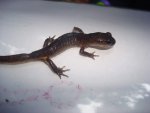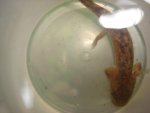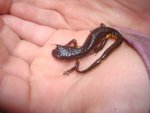I took 6 kids with me over two days. Ages ranged from 9 years old to 4 years old. All kids enjoyed view nature up close, especially since 3 of the kids were from Las Vegas.
OF course I found Ensatina, but I know I found E.e.picta and some other type. Looks to be a hybrid intergrade of E.e.oregonesis X E.e.platenus. This sepcimen fit the description in my Field Guide, but I don't know if the range is right.
I found larval D. tenebrosus every time I popped down into a stream. My kids especially like catching them. I found some that were approx. 2 inches long and ones that were approximately 5 inches long. In some cases they were co-inhabiting the same slow moving pooled section of the stream.
I have a fuzzy picture of what I believe to be larval R. variegatus. This is a possible find since there has been documented accounts in the area I found them in. I found two in the same area. They were considerably smaller than the D. tenebrosus larva.
I also found a B. attenuatus but the little 4 year old girl that whose turn it was to hold the camera did not get there quick enough to take a picture.
I had a blast teaching the kids about nature. I was also able to use my information for a BIOLOGY project about ecosystems. SO it was a win win situation.
OF course I found Ensatina, but I know I found E.e.picta and some other type. Looks to be a hybrid intergrade of E.e.oregonesis X E.e.platenus. This sepcimen fit the description in my Field Guide, but I don't know if the range is right.
I found larval D. tenebrosus every time I popped down into a stream. My kids especially like catching them. I found some that were approx. 2 inches long and ones that were approximately 5 inches long. In some cases they were co-inhabiting the same slow moving pooled section of the stream.
I have a fuzzy picture of what I believe to be larval R. variegatus. This is a possible find since there has been documented accounts in the area I found them in. I found two in the same area. They were considerably smaller than the D. tenebrosus larva.
I also found a B. attenuatus but the little 4 year old girl that whose turn it was to hold the camera did not get there quick enough to take a picture.
I had a blast teaching the kids about nature. I was also able to use my information for a BIOLOGY project about ecosystems. SO it was a win win situation.
Attachments
Last edited by a moderator:








